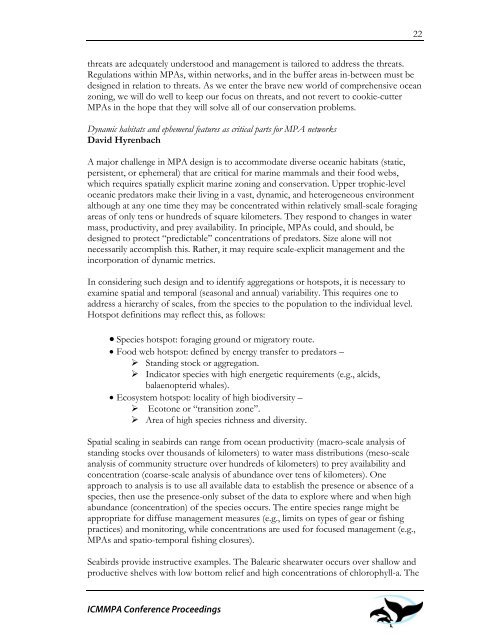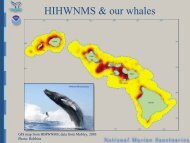The First International Conference on Marine Mammal Protected Areas
The First International Conference on Marine Mammal Protected Areas
The First International Conference on Marine Mammal Protected Areas
You also want an ePaper? Increase the reach of your titles
YUMPU automatically turns print PDFs into web optimized ePapers that Google loves.
threats are adequately understood and management is tailored to address the threats.<br />
Regulati<strong>on</strong>s within MPAs, within networks, and in the buffer areas in-between must be<br />
designed in relati<strong>on</strong> to threats. As we enter the brave new world of comprehensive ocean<br />
z<strong>on</strong>ing, we will do well to keep our focus <strong>on</strong> threats, and not revert to cookie-cutter<br />
MPAs in the hope that they will solve all of our c<strong>on</strong>servati<strong>on</strong> problems.<br />
Dynamic habitats and ephemeral features as critical parts for MPA networks<br />
David Hyrenbach<br />
A major challenge in MPA design is to accommodate diverse oceanic habitats (static,<br />
persistent, or ephemeral) that are critical for marine mammals and their food webs,<br />
which requires spatially explicit marine z<strong>on</strong>ing and c<strong>on</strong>servati<strong>on</strong>. Upper trophic-level<br />
oceanic predators make their living in a vast, dynamic, and heterogeneous envir<strong>on</strong>ment<br />
although at any <strong>on</strong>e time they may be c<strong>on</strong>centrated within relatively small-scale foraging<br />
areas of <strong>on</strong>ly tens or hundreds of square kilometers. <str<strong>on</strong>g>The</str<strong>on</strong>g>y resp<strong>on</strong>d to changes in water<br />
mass, productivity, and prey availability. In principle, MPAs could, and should, be<br />
designed to protect “predictable” c<strong>on</strong>centrati<strong>on</strong>s of predators. Size al<strong>on</strong>e will not<br />
necessarily accomplish this. Rather, it may require scale-explicit management and the<br />
incorporati<strong>on</strong> of dynamic metrics.<br />
In c<strong>on</strong>sidering such design and to identify aggregati<strong>on</strong>s or hotspots, it is necessary to<br />
examine spatial and temporal (seas<strong>on</strong>al and annual) variability. This requires <strong>on</strong>e to<br />
address a hierarchy of scales, from the species to the populati<strong>on</strong> to the individual level.<br />
Hotspot definiti<strong>on</strong>s may reflect this, as follows:<br />
• Species hotspot: foraging ground or migratory route.<br />
• Food web hotspot: defined by energy transfer to predators –<br />
� Standing stock or aggregati<strong>on</strong>.<br />
� Indicator species with high energetic requirements (e.g., alcids,<br />
balaenopterid whales).<br />
• Ecosystem hotspot: locality of high biodiversity –<br />
� Ecot<strong>on</strong>e or “transiti<strong>on</strong> z<strong>on</strong>e”.<br />
� Area of high species richness and diversity.<br />
Spatial scaling in seabirds can range from ocean productivity (macro-scale analysis of<br />
standing stocks over thousands of kilometers) to water mass distributi<strong>on</strong>s (meso-scale<br />
analysis of community structure over hundreds of kilometers) to prey availability and<br />
c<strong>on</strong>centrati<strong>on</strong> (coarse-scale analysis of abundance over tens of kilometers). One<br />
approach to analysis is to use all available data to establish the presence or absence of a<br />
species, then use the presence-<strong>on</strong>ly subset of the data to explore where and when high<br />
abundance (c<strong>on</strong>centrati<strong>on</strong>) of the species occurs. <str<strong>on</strong>g>The</str<strong>on</strong>g> entire species range might be<br />
appropriate for diffuse management measures (e.g., limits <strong>on</strong> types of gear or fishing<br />
practices) and m<strong>on</strong>itoring, while c<strong>on</strong>centrati<strong>on</strong>s are used for focused management (e.g.,<br />
MPAs and spatio-temporal fishing closures).<br />
Seabirds provide instructive examples. <str<strong>on</strong>g>The</str<strong>on</strong>g> Balearic shearwater occurs over shallow and<br />
productive shelves with low bottom relief and high c<strong>on</strong>centrati<strong>on</strong>s of chlorophyll-a. <str<strong>on</strong>g>The</str<strong>on</strong>g><br />
ICMMPA <str<strong>on</strong>g>C<strong>on</strong>ference</str<strong>on</strong>g> Proceedings<br />
22



